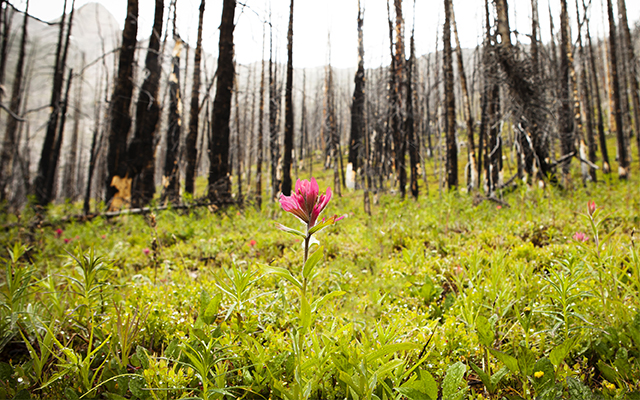In 2013, Matt Jones and his girlfriend, Sarah, hiked across the Grand Canyon. Upon returning to their Chicago home, Sarah felt exceptionally tired and sore. Weeks passed and her energy declined further. Soon, she couldn’t even get out of bed.
Only several months later would Sarah receive a diagnosis: Lyme disease. Because the infection had gone untreated for so long — and because she had suffered a concussion around the same time — the disease spread to her brain. Alongside the precipitous decline in energy, focus, and general functioning, Matt noticed more disturbing changes. Sarah was no longer interested in friends or hobbies; she spent nearly all her time in the bedroom or bathroom.
“Her personality changed,” he recalls. “She no longer had any joy for life. I realized that the person I fell in love with was no longer there.”
Loss Without End
“Absence and presence are not absolutes,” writes University of Minnesota emeritus professor Pauline Boss, PhD, in her 2006 book Loss, Trauma and Resilience: Therapeutic Work With Ambiguous Loss. “Human relationships are more complex.”
Boss worked with clients whose loved ones went missing in war or natural disasters. The survivors existed in a kind of limbo, she discovered, unsure when or how to mourn those who may or may not still be alive. She created the term “ambiguous loss” to capture this distinct — and often devastating — experience.
As painful as it is to lose a loved one, death is nothing if not certain. By contrast, ambiguous loss is a loss without finality. How do we find “closure” — an elusive goal even within the context of traditional loss — when we’re not even sure the door has closed?
Ambiguous loss takes two forms. One entails the physical absence of a loved one whose return is uncertain. Examples include incarceration, deportation, or kidnapping. Another form involves loved ones who are physically present but psychologically absent due to conditions such as Alzheimer’s disease, brain injury, or chronic mental illness. Matt entered this realm when Sarah descended into psychological dysfunction, rendering a once active, vibrant young woman detached and depressed.
The inconclusive nature of [ambiguous] loss often begets confusion, loneliness, and a sense of being trapped in limbo.
The inconclusive nature of such loss often begets confusion, loneliness, and a sense of being trapped in limbo. Furthermore, these losses tend to go unrecognized. When a loved one dies, we can find comfort in the customs that follow — the funeral, flowers, and condolences. Friends, family, and coworkers offer space and support for grieving. Rarely do such conventions follow an ambiguous loss.
Meanwhile, it can be incredibly difficult to maintain or define our role in relation to the person we have lost. If a partner is deported or goes missing in war, should we open ourselves up to a new relationship? What if, as in Matt’s case, the partner remains in the home but is no longer the person we once knew?
At times Sarah’ss condition seemed to improve, then without warning she’d regress. Matt stayed by her side. They married and he took on a caregiver role. Matt recalls this period as one rife with denial: He struggled to accept Sarah’s condition, clinging to the belief that she would bounce back. But he also felt resentment — and guilt.
“Taking on the role of caregiver, husband, and best friend was a huge burden,” he says. “Our relationship was completely one-sided for a while — which is not a partnership.”
Matt struggled to acknowledge these feelings, let alone share them with others. For a time, he became isolated and depressed just like Sarah — frozen, as Boss describes it, in the grieving process.
Moving Forward
Navigating ambiguous loss demands a re-working — or even outright rejection — of conventional attitudes toward grief.
This often entails relinquishing responsibility over the circumstances. Ambiguous loss is almost always a function of external circumstances beyond anyone’s control; accepting this helps free survivors from feelings of shame and self-recrimination.
Community is also essential to healing. Because ambiguous losses typically lack formal grieving rituals, it’s especially important for survivors to lean on others for support. In fact, a study of Italians who lost a loved one to COVID-19 (see “Ambiguous Loss During the Pandemic” below) identified social media as a key conduit for survivors’ healing.
Often entire families contend with ambiguous loss. In these cases, family members must redefine their roles, routines, and expectations according to the changed circumstances rather than waiting for a return to the familiar.
Moving forward is different from moving on, however. Coping is not about finding closure but about learning to live with ambiguity, and this requires acknowledging complicated emotions. In Matt’s case, it meant recognizing that he had bound his own happiness to Sarah’s.
Moving forward is different from moving on. Coping is not about finding closure but about learning to live with ambiguity, and this requires acknowledging complicated emotions.
“For a long time, I felt guilty when I was happy,” he says. “I had to accept that I deserve happiness even though my partner is suffering.”
Through therapy, meditation, and other forms of self-inquiry, Matt began to let go of what he calls a “false sense of hope” regarding Sarah’s recovery. He began to realize that remaining “stuck” in this hope only prevented genuine healing.
Such acceptance is essential to the healing process. Often (but not always) fostered through spirituality or religion, acceptance of the situation’s essential intractability enables us to find resolution within ourselves.
Accepting unchangeable situations does not have to mean accepting the forces that created those situations. Insisting on change can be empowering for those whom acceptance of unfair circumstances has been the norm. In these cases, identifying productive ways to channel anger, such as advocating for systemic changes, can be a healthy part of the coping process.
Sometimes the necessary changes happen on a smaller scale. Recently, Matt and Sarah — who has made enormous strides in her mental and physical recovery — agreed to go their separate ways.
“We love each other dearly,” he says. “But we both need to move forward.”
As he transitions into a new life phase, Matt feels an unexpected gratitude for the experience. Through it, he has cultivated a clarity of purpose and an appreciation for life’s inherent uncertainty.
“I have learned how to surrender,” he explains. “I can’t prevent bad things from happening, but I can choose not to engage in needless suffering.”
Ambiguous Loss During the Pandemic
The global outbreak of COVID-19 has generated losses of all kinds. Loss of life, of course, but also loss of work, plans, and rites of passage like weddings and graduation ceremonies. We’ve also been forced to reckon with the loss of normalcy and predictability as we continue to wonder when — if ever — our lives will feel familiar again.
“I would wager that everyone could make a list of what they’ve lost during this pandemic,” Pauline Boss, PhD, author of The Myth of Closure: Ambiguous Loss in a Time of Pandemic and Change, noted in a 2020 interview. “The loss of whatever it is you did before.”
Even death became imbued with more ambiguity. During the height of the pandemic, people were often unable to be present with dying loved ones or host in-personal funerals. In a study of Italians who lost a loved one during the height of that country’s pandemic, survivors reported feelings of abandonment, anger, and resentment. Many struggled to accept the reality of the loss, largely because they hadn’t been able to see their loved one pass.
We still don’t know when the pandemic will end; what life will look like in a year or even a month from now. The stress of constant ambiguity is no small thing, nor is the loss of whatever came before. All the more reason to recognize and treat this as a time for grieving and healing.





This Post Has One Comment
My Husband was diagnosed with glioblastoma in early April 2012. Since then he has had three craniotomies, 3 years of chemotherapy and 6 weeks of radiation. Needless to say, he is not the man I married 27 years ago. The last 10 years have been a roller-coaster of ups and downs. Emotions at every end of the spectrum, from frustration, sadness, anger, mourning, begging to God … I have spent two short winters alone in Florida. I ask God every day to help me have the strength to leave for the sake of my physical and mental health. A friend whose husband died recently after 14 months with this same cancer sent me this article and I cried that there are others out there like me.